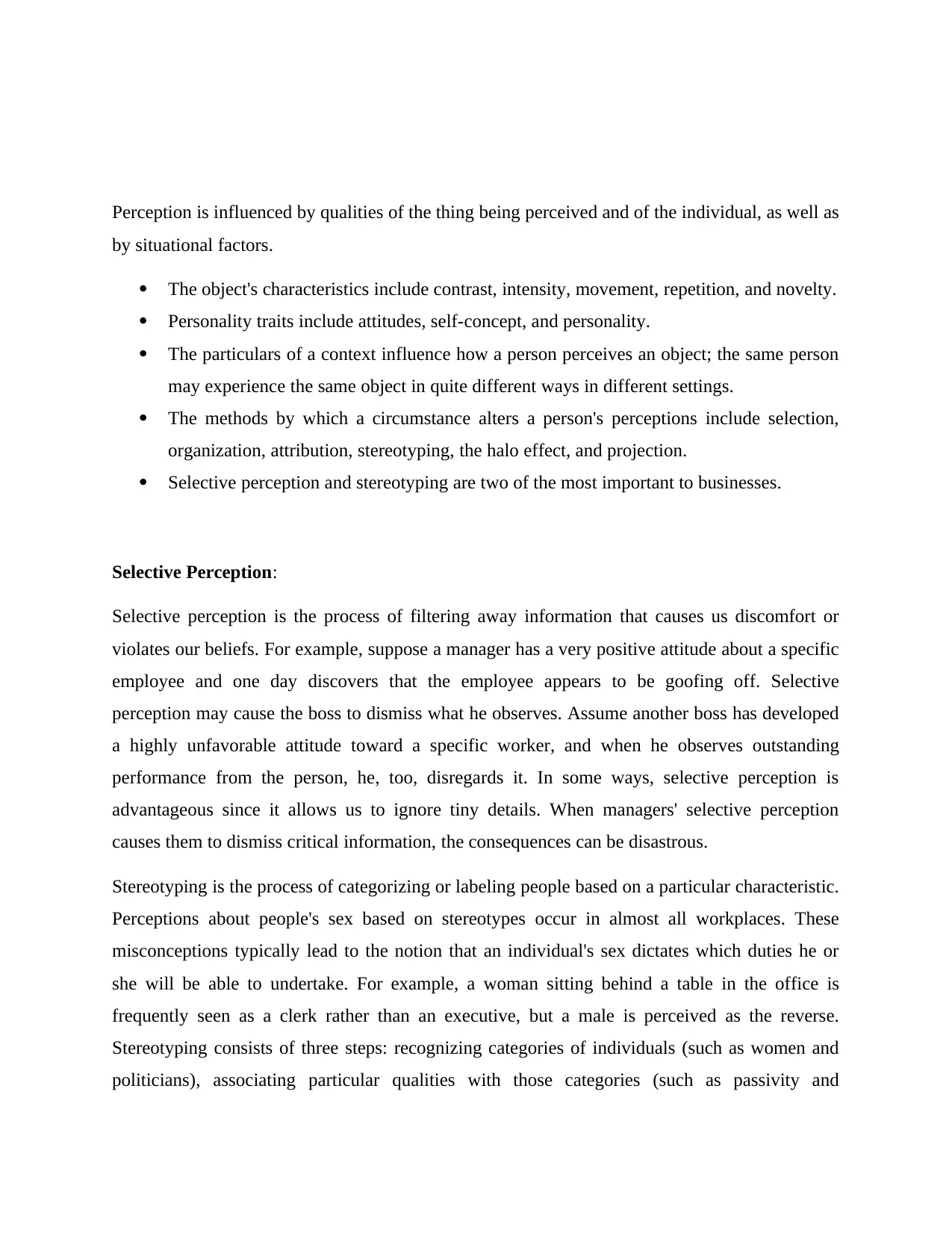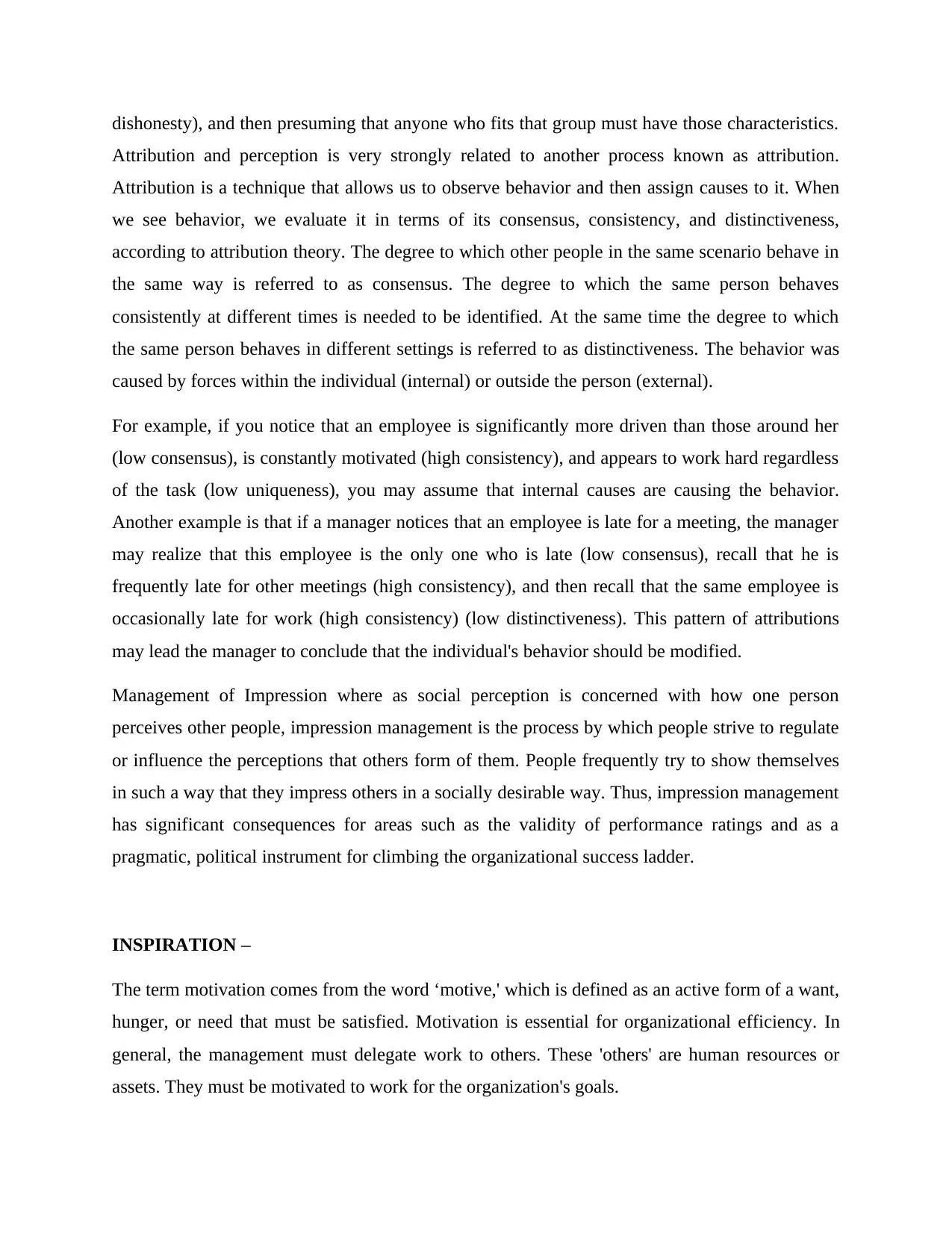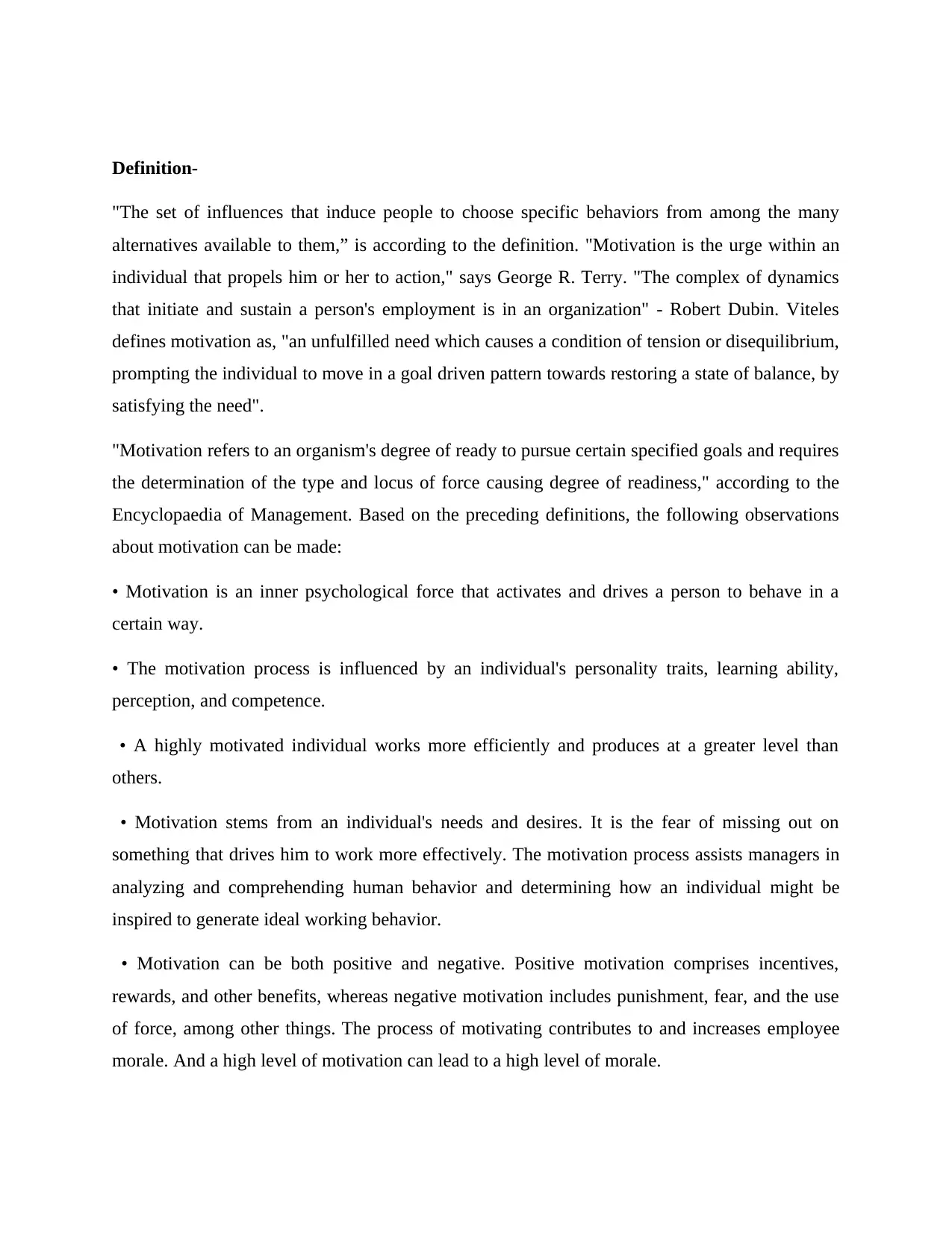Leadership: Exploring Perception, Attribution, and Motivation
VerifiedAdded on 2023/02/07
|3
|1158
|26
Essay
AI Summary
This essay delves into the interconnected concepts of perception and motivation within the context of leadership. It explores how individuals perceive information, including the influence of object characteristics, personal traits, and situational factors. The essay highlights specific perceptual biases such as selective perception and stereotyping, and their significant impact on managerial decisions. Furthermore, it examines attribution theory, which explains how individuals assign causes to observed behaviors, and how this process influences leadership. The essay then transitions to a discussion of motivation, defining it as the driving force behind human actions and exploring its importance in organizational efficiency. Various definitions of motivation are presented, emphasizing its psychological nature and the impact of needs and desires on employee behavior. The essay concludes by emphasizing the relationship between motivation and morale, highlighting the role of motivation in analyzing human behavior and inspiring optimal work performance.

Perception is influenced by qualities of the thing being perceived and of the individual, as well as
by situational factors.
The object's characteristics include contrast, intensity, movement, repetition, and novelty.
Personality traits include attitudes, self-concept, and personality.
The particulars of a context influence how a person perceives an object; the same person
may experience the same object in quite different ways in different settings.
The methods by which a circumstance alters a person's perceptions include selection,
organization, attribution, stereotyping, the halo effect, and projection.
Selective perception and stereotyping are two of the most important to businesses.
Selective Perception:
Selective perception is the process of filtering away information that causes us discomfort or
violates our beliefs. For example, suppose a manager has a very positive attitude about a specific
employee and one day discovers that the employee appears to be goofing off. Selective
perception may cause the boss to dismiss what he observes. Assume another boss has developed
a highly unfavorable attitude toward a specific worker, and when he observes outstanding
performance from the person, he, too, disregards it. In some ways, selective perception is
advantageous since it allows us to ignore tiny details. When managers' selective perception
causes them to dismiss critical information, the consequences can be disastrous.
Stereotyping is the process of categorizing or labeling people based on a particular characteristic.
Perceptions about people's sex based on stereotypes occur in almost all workplaces. These
misconceptions typically lead to the notion that an individual's sex dictates which duties he or
she will be able to undertake. For example, a woman sitting behind a table in the office is
frequently seen as a clerk rather than an executive, but a male is perceived as the reverse.
Stereotyping consists of three steps: recognizing categories of individuals (such as women and
politicians), associating particular qualities with those categories (such as passivity and
by situational factors.
The object's characteristics include contrast, intensity, movement, repetition, and novelty.
Personality traits include attitudes, self-concept, and personality.
The particulars of a context influence how a person perceives an object; the same person
may experience the same object in quite different ways in different settings.
The methods by which a circumstance alters a person's perceptions include selection,
organization, attribution, stereotyping, the halo effect, and projection.
Selective perception and stereotyping are two of the most important to businesses.
Selective Perception:
Selective perception is the process of filtering away information that causes us discomfort or
violates our beliefs. For example, suppose a manager has a very positive attitude about a specific
employee and one day discovers that the employee appears to be goofing off. Selective
perception may cause the boss to dismiss what he observes. Assume another boss has developed
a highly unfavorable attitude toward a specific worker, and when he observes outstanding
performance from the person, he, too, disregards it. In some ways, selective perception is
advantageous since it allows us to ignore tiny details. When managers' selective perception
causes them to dismiss critical information, the consequences can be disastrous.
Stereotyping is the process of categorizing or labeling people based on a particular characteristic.
Perceptions about people's sex based on stereotypes occur in almost all workplaces. These
misconceptions typically lead to the notion that an individual's sex dictates which duties he or
she will be able to undertake. For example, a woman sitting behind a table in the office is
frequently seen as a clerk rather than an executive, but a male is perceived as the reverse.
Stereotyping consists of three steps: recognizing categories of individuals (such as women and
politicians), associating particular qualities with those categories (such as passivity and
Paraphrase This Document
Need a fresh take? Get an instant paraphrase of this document with our AI Paraphraser

dishonesty), and then presuming that anyone who fits that group must have those characteristics.
Attribution and perception is very strongly related to another process known as attribution.
Attribution is a technique that allows us to observe behavior and then assign causes to it. When
we see behavior, we evaluate it in terms of its consensus, consistency, and distinctiveness,
according to attribution theory. The degree to which other people in the same scenario behave in
the same way is referred to as consensus. The degree to which the same person behaves
consistently at different times is needed to be identified. At the same time the degree to which
the same person behaves in different settings is referred to as distinctiveness. The behavior was
caused by forces within the individual (internal) or outside the person (external).
For example, if you notice that an employee is significantly more driven than those around her
(low consensus), is constantly motivated (high consistency), and appears to work hard regardless
of the task (low uniqueness), you may assume that internal causes are causing the behavior.
Another example is that if a manager notices that an employee is late for a meeting, the manager
may realize that this employee is the only one who is late (low consensus), recall that he is
frequently late for other meetings (high consistency), and then recall that the same employee is
occasionally late for work (high consistency) (low distinctiveness). This pattern of attributions
may lead the manager to conclude that the individual's behavior should be modified.
Management of Impression where as social perception is concerned with how one person
perceives other people, impression management is the process by which people strive to regulate
or influence the perceptions that others form of them. People frequently try to show themselves
in such a way that they impress others in a socially desirable way. Thus, impression management
has significant consequences for areas such as the validity of performance ratings and as a
pragmatic, political instrument for climbing the organizational success ladder.
INSPIRATION –
The term motivation comes from the word ‘motive,' which is defined as an active form of a want,
hunger, or need that must be satisfied. Motivation is essential for organizational efficiency. In
general, the management must delegate work to others. These 'others' are human resources or
assets. They must be motivated to work for the organization's goals.
Attribution and perception is very strongly related to another process known as attribution.
Attribution is a technique that allows us to observe behavior and then assign causes to it. When
we see behavior, we evaluate it in terms of its consensus, consistency, and distinctiveness,
according to attribution theory. The degree to which other people in the same scenario behave in
the same way is referred to as consensus. The degree to which the same person behaves
consistently at different times is needed to be identified. At the same time the degree to which
the same person behaves in different settings is referred to as distinctiveness. The behavior was
caused by forces within the individual (internal) or outside the person (external).
For example, if you notice that an employee is significantly more driven than those around her
(low consensus), is constantly motivated (high consistency), and appears to work hard regardless
of the task (low uniqueness), you may assume that internal causes are causing the behavior.
Another example is that if a manager notices that an employee is late for a meeting, the manager
may realize that this employee is the only one who is late (low consensus), recall that he is
frequently late for other meetings (high consistency), and then recall that the same employee is
occasionally late for work (high consistency) (low distinctiveness). This pattern of attributions
may lead the manager to conclude that the individual's behavior should be modified.
Management of Impression where as social perception is concerned with how one person
perceives other people, impression management is the process by which people strive to regulate
or influence the perceptions that others form of them. People frequently try to show themselves
in such a way that they impress others in a socially desirable way. Thus, impression management
has significant consequences for areas such as the validity of performance ratings and as a
pragmatic, political instrument for climbing the organizational success ladder.
INSPIRATION –
The term motivation comes from the word ‘motive,' which is defined as an active form of a want,
hunger, or need that must be satisfied. Motivation is essential for organizational efficiency. In
general, the management must delegate work to others. These 'others' are human resources or
assets. They must be motivated to work for the organization's goals.

Definition-
"The set of influences that induce people to choose specific behaviors from among the many
alternatives available to them,” is according to the definition. "Motivation is the urge within an
individual that propels him or her to action," says George R. Terry. "The complex of dynamics
that initiate and sustain a person's employment is in an organization" - Robert Dubin. Viteles
defines motivation as, "an unfulfilled need which causes a condition of tension or disequilibrium,
prompting the individual to move in a goal driven pattern towards restoring a state of balance, by
satisfying the need".
"Motivation refers to an organism's degree of ready to pursue certain specified goals and requires
the determination of the type and locus of force causing degree of readiness," according to the
Encyclopaedia of Management. Based on the preceding definitions, the following observations
about motivation can be made:
• Motivation is an inner psychological force that activates and drives a person to behave in a
certain way.
• The motivation process is influenced by an individual's personality traits, learning ability,
perception, and competence.
• A highly motivated individual works more efficiently and produces at a greater level than
others.
• Motivation stems from an individual's needs and desires. It is the fear of missing out on
something that drives him to work more effectively. The motivation process assists managers in
analyzing and comprehending human behavior and determining how an individual might be
inspired to generate ideal working behavior.
• Motivation can be both positive and negative. Positive motivation comprises incentives,
rewards, and other benefits, whereas negative motivation includes punishment, fear, and the use
of force, among other things. The process of motivating contributes to and increases employee
morale. And a high level of motivation can lead to a high level of morale.
"The set of influences that induce people to choose specific behaviors from among the many
alternatives available to them,” is according to the definition. "Motivation is the urge within an
individual that propels him or her to action," says George R. Terry. "The complex of dynamics
that initiate and sustain a person's employment is in an organization" - Robert Dubin. Viteles
defines motivation as, "an unfulfilled need which causes a condition of tension or disequilibrium,
prompting the individual to move in a goal driven pattern towards restoring a state of balance, by
satisfying the need".
"Motivation refers to an organism's degree of ready to pursue certain specified goals and requires
the determination of the type and locus of force causing degree of readiness," according to the
Encyclopaedia of Management. Based on the preceding definitions, the following observations
about motivation can be made:
• Motivation is an inner psychological force that activates and drives a person to behave in a
certain way.
• The motivation process is influenced by an individual's personality traits, learning ability,
perception, and competence.
• A highly motivated individual works more efficiently and produces at a greater level than
others.
• Motivation stems from an individual's needs and desires. It is the fear of missing out on
something that drives him to work more effectively. The motivation process assists managers in
analyzing and comprehending human behavior and determining how an individual might be
inspired to generate ideal working behavior.
• Motivation can be both positive and negative. Positive motivation comprises incentives,
rewards, and other benefits, whereas negative motivation includes punishment, fear, and the use
of force, among other things. The process of motivating contributes to and increases employee
morale. And a high level of motivation can lead to a high level of morale.
⊘ This is a preview!⊘
Do you want full access?
Subscribe today to unlock all pages.

Trusted by 1+ million students worldwide
1 out of 3
Your All-in-One AI-Powered Toolkit for Academic Success.
+13062052269
info@desklib.com
Available 24*7 on WhatsApp / Email
![[object Object]](/_next/static/media/star-bottom.7253800d.svg)
Unlock your academic potential
Copyright © 2020–2025 A2Z Services. All Rights Reserved. Developed and managed by ZUCOL.
